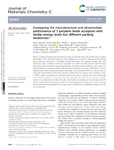Mostrar o rexistro simple do ítem
Comparing the Microstructure and Photovoltaic Performance of 3 Perylene Imide Acceptors With Similar Energy Levels but Different Packing Tendencies
| dc.contributor.author | Adel, Rana | |
| dc.contributor.author | Gala, Elena | |
| dc.contributor.author | Alonso Navarro, Matías Jesús | |
| dc.contributor.author | Gutiérrez Fernández, Edgar | |
| dc.contributor.author | Martín, Jaime | |
| dc.contributor.author | Stella, Marco | |
| dc.contributor.author | Martínez-Ferrero, Eugenia | |
| dc.contributor.author | de la Peña, Alejandro | |
| dc.contributor.author | Harbuzaru Harbuzaru, Alexandra | |
| dc.contributor.author | Ramos, M.Mar | |
| dc.contributor.author | Ponce Ortiz, Rocío | |
| dc.contributor.author | Segura, José L. | |
| dc.contributor.author | Campoy-Quiles, Mariano | |
| dc.date.accessioned | 2022-04-28T10:24:11Z | |
| dc.date.available | 2022-04-28T10:24:11Z | |
| dc.date.issued | 2022 | |
| dc.identifier.citation | Adel, Rana, et al. «Comparing the Microstructure and Photovoltaic Performance of 3 Perylene Imide Acceptors with Similar Energy Levels but Different Packing Tendencies». Journal of Materials Chemistry C, vol. 10, n.o 5, 2022, pp. 1698-710. https://doi.org/10.1039/D1TC05037K. | es_ES |
| dc.identifier.issn | 2050-7534 | |
| dc.identifier.uri | http://hdl.handle.net/2183/30548 | |
| dc.description.abstract | [Abstract] While it is widely recognized that microstructure plays an important role in the performance of organic photovoltaics (OPV), systematic studies are often challenging, as varying the molecular packing through typical chemical means (such as sidechain tuning) often affects the molecular energy levels, thus preventing a clear correlation. In this work we present the synthesis of three perylene imide (PI) based electron acceptors with almost identical energy levels, but distinct packing tendencies. We confirm our initial hypothesis by measuring solution and solid-state absorption, and cyclic voltammetry as well as characterizing the films by grazing incidence wide angle X-ray scattering (GIWAXS). In a second step, we repeat the characterization of the three materials in blends with two polymer donors, namely PCDTBT or PBDBT, whose energy levels are well aligned with those of the PI acceptors, and which, additionally, exhibit different degrees of structural order. We show how the initial strong difference between acceptors is partially blurred in blends, but still critical. Finally, we correlate our structural data with OPV devices made with the corresponding six blends. Our data suggest that a good donor acceptor marriage should ensure good energy alignment but also exhibit complementary crystallization tendencies of the two components. | es_ES |
| dc.description.sponsorship | The authors acknowledge financial support from the Spanish Ministry of Science and Innovation through the Severo Ochoa Program for Centers of Excellence in R&D (No. CEX2019-000917-S), and projects PGC2018-095411-B-I00, PID2019-106268GB-C33 and PID2019-110305GB-I00, as well as the European Commission through the Horizon 2020 Marie Sklodowska-Curie ITN Programme, SEPOMO, Grant Number: 722651, and the UCM (INV.GR.00.1819.10759). E. G. specially acknowledges Comunidad de Madrid and Universidad Complutense de Madrid for a post-doctoral contract (CT20/19-CT21/19/PEJD-2018-POST/IND-8661PAI). M. J. A. N. acknowledges URJC for a post-doctoral contract. R. P. O. and A. H. also acknowledge support from Junta de Andalucía (project UMA18-FEDERJA-080). We acknowledge support of the publication fee by the CSIC Open Access Publication Support Initiative through its Unit of Information Resources for Research (URICI) | es_ES |
| dc.description.sponsorship | Universidad Complutense de Madrid; INV.GR.00.1819.10759 | es_ES |
| dc.description.sponsorship | Universidad Complutense de Madrid; CT20/19-CT21/19/PEJD-2018-POST/IND-8661PAI | es_ES |
| dc.description.sponsorship | Junta de Andalucía; UMA18-FEDERJA-080 | es_ES |
| dc.language.iso | eng | es_ES |
| dc.publisher | Royal Society of Chemistry | es_ES |
| dc.relation | info:eu-repo/grantAgreement/EC/H2020/722651 | es_ES |
| dc.relation | info:eu-repo/grantAgreement/MICINN/Plan Estatal de Investigación Científica y Técnica y de Innovación 2017-2020/CEX2019-000917-S/ES/ | |
| dc.relation | info:eu-repo/grantAgreement/AEI/Plan Estatal de Investigación Científica y Técnica y de Innovación 2017-2020/PGC2018-095411-B-I00/ES/CONVERSION EFICIENTE DE ENERGIA SOLAR VISIBLE E INFRARROJA MEDIANTE ARQUITECTURAS DE TIPO ARCOIRIS/ | |
| dc.relation | info:eu-repo/grantAgreement/AEI/Plan Estatal de Investigación Científica y Técnica y de Innovación 2017-2020/PID2019-106268GB-C33/ES/DISEÑO DE MATERIALES 2D PARA APLICACIONES EN ENERGIA: REDES ORGANICAS COVALENTES/ | |
| dc.relation | info:eu-repo/grantAgreement/AEI/Plan Estatal de Investigación Científica y Técnica y de Innovación 2017-2020/PID2019-110305GB-I00/ES/ESTUDIO DE LOS PROCESOS FISICOQUIMICOS INVOLUCRADOS EN EL FUNCIONAMIENTO DE DISPOSITIVOS ELECTRONICOS Y FOTONICOS ORGANICOS/ | |
| dc.relation.uri | https://doi.org/10.1039/D1TC05037K | es_ES |
| dc.rights | Atribución 3.0 | es_ES |
| dc.rights.uri | http://creativecommons.org/licenses/by/3.0/ | * |
| dc.title | Comparing the Microstructure and Photovoltaic Performance of 3 Perylene Imide Acceptors With Similar Energy Levels but Different Packing Tendencies | es_ES |
| dc.type | info:eu-repo/semantics/article | es_ES |
| dc.rights.access | info:eu-repo/semantics/openAccess | es_ES |
| UDC.journalTitle | Journal of Materials Chemistry C | es_ES |
| UDC.startPage | 1698 | es_ES |
| UDC.endPage | 1710 | es_ES |
| dc.identifier.doi | 10.1039/D1TC05037K |
Ficheiros no ítem
Este ítem aparece na(s) seguinte(s) colección(s)
-
GI-Polímeros - Artigos [32]
-
OpenAIRE [359]






